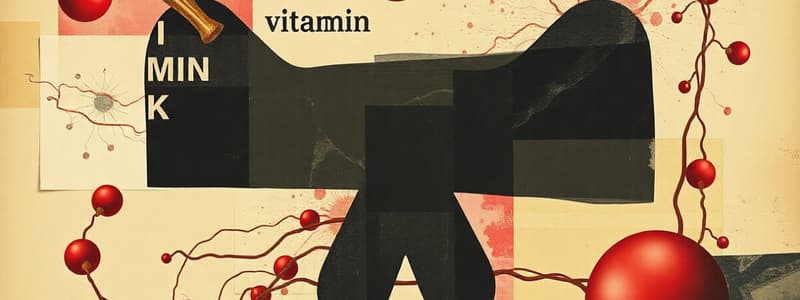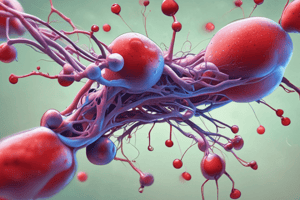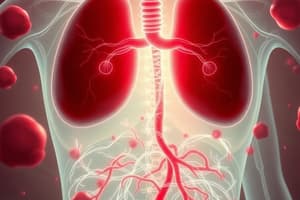Podcast
Questions and Answers
Which step in the Vitamin K cycle is directly inhibited by Warfarin?
Which step in the Vitamin K cycle is directly inhibited by Warfarin?
- Reduction of vitamin K epoxide to vitamin K quinone. (correct)
- Oxidation of vitamin K hydroquinone to vitamin K epoxide.
- Carboxylation of coagulation factors by gamma glutamyl carboxylase.
- Conversion of vitamin K quinone to vitamin K hydroquinone.
What is the role of gamma glutamyl carboxylase in the process of blood coagulation?
What is the role of gamma glutamyl carboxylase in the process of blood coagulation?
- It converts non-functional coagulation factors II, VII, IX, and X into their functional forms. (correct)
- It reduces vitamin K quinone to vitamin K hydroquinone.
- It activates factor XII in the intrinsic pathway.
- It activates factor VII in the extrinsic pathway.
Which coagulation factors are directly dependent on vitamin K for their proper function?
Which coagulation factors are directly dependent on vitamin K for their proper function?
- Factors V, VIII, and XIII.
- Factors II, VII, IX, and X. (correct)
- Tissue factor and activated platelets.
- Factors XI, XII, and I.
In the intrinsic pathway, which factor is activated directly by factor XII?
In the intrinsic pathway, which factor is activated directly by factor XII?
If a patient has a severe vitamin K deficiency, which pathway(s) of the coagulation cascade would be most affected?
If a patient has a severe vitamin K deficiency, which pathway(s) of the coagulation cascade would be most affected?
Which event marks the beginning of the common pathway in the coagulation cascade?
Which event marks the beginning of the common pathway in the coagulation cascade?
What role do activated factors V and VIII play in the coagulation cascade?
What role do activated factors V and VIII play in the coagulation cascade?
How does Vitamin K contribute to the functionality of coagulation factors?
How does Vitamin K contribute to the functionality of coagulation factors?
Flashcards
Vitamin K's Role
Vitamin K's Role
Regulates blood coagulation by assisting in the maturation of coagulation factors.
Vitamin cycle
Vitamin cycle
A series of oxidation and reduction reactions that recycle Vitamin K, allowing it to be reused.
Quinone Reductase
Quinone Reductase
Enzyme that converts vitamin K quinone to vitamin K hydroquinone using electrons from NADPH.
Gamma-Glutamyl Carboxylase
Gamma-Glutamyl Carboxylase
Signup and view all the flashcards
Warfarin
Warfarin
Signup and view all the flashcards
Extrinsic Pathway
Extrinsic Pathway
Signup and view all the flashcards
Intrinsic Pathway
Intrinsic Pathway
Signup and view all the flashcards
Common Pathway
Common Pathway
Signup and view all the flashcards
Study Notes
- Vitamin K regulates blood coagulation.
- Vitamin K assists the conversion of coagulation factors into mature forms.
- The body cannot control clot formation without vitamin K.
- Production of coagulation factors II, VII, IX, and X requires an enzyme that utilizes vitamin K.
- Vitamin K Cycle: A series of oxidation and reduction reactions that recycle Vitamin K.
- Dietary form of Vitamin K: vitamin K quinone.
- Quinone reductase uses electrons from NADPH to convert vitamin K quinone into vitamin K hydroquinone.
- Vitamin K hydroquinone donates electrons to gamma glutamyl carboxylase.
- Gamma glutamyl carboxylase converts non-functional coagulation factors II, VII, IX, and X into functional forms.
- Vitamin K is oxidized into vitamin K epoxide.
- Vitamin K epoxide receives electrons via epoxide reductase, reverting to vitamin K quinone.
- A single molecule of vitamin K can be reused many times.
- Warfarin inhibits epoxide reductase function, preventing vitamin K recycling, which hinders the activation of Factors II, VII, IX, and X.
- The coagulation cascade initiates via the extrinsic and intrinsic pathways.
- The intrinsic pathway starts when circulating factor XII contacts activated platelets or collagen.
- Activated factor XII activates factor XI, which activates factor IX, which activates factor X.
- Factor X starts the common pathway where it activates factor II, which activates factor I that builds the fibrin mesh.
- Activated factor II also activates factors V, VIII, XI, and XIII.
- Activated factor V acts as a cofactor for X, factor VIII acts as a cofactor for factor IX, and factor XIII helps factor I, fibrin, form crosslinks.
- In the extrinsic pathway, exposed tissue factor activates factor VII, which activates factor X, initiating the common pathway.
- Without vitamin K, the loss of factor VII impairs the extrinsic pathway; loss of factor IX impairs the intrinsic pathway; loss of factor X and II impairs the common pathway.
- Because factors II, VII, IX, and X are utilized in all three pathways, clot formation won’t function properly unless our body properly utilizes vitamin K.
Studying That Suits You
Use AI to generate personalized quizzes and flashcards to suit your learning preferences.



